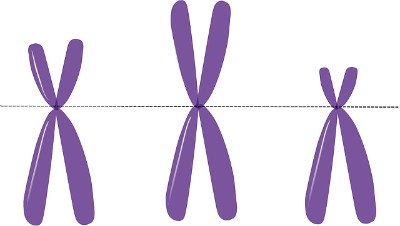The chromosome number is one of the primary bases of hybridization in agricultural crops as well as in animals.
The diploid numbers of chromosomes are essentially constant within the same species.
It is an important topic of review in basic plant breeding.

It is the general rule that successful crosses are easier to achieve between individual plants under the same species rather than between different species under the same genus (interspecific cross).
Consequently, it is more difficult to produce an intergeneric hybrid. In sum, individuals which are closely related taxonomically are much easier to cross.
However, it is not the diploid chromosome number alone that determines the ability of two parents to readily form a hybrid.
The main determinant is the karyotype, referring to the number, as well as the size and shape of the chromosomes of an individual.
Other considerations are the types of sex chromosomes, lethal genes, and polyploidy.
Listed in the table below are the diploid chromosome numbers of some agricultural crops and various animal species.
Sources of information are provided.
Chromosome Number of Selected Species
Table CN-1. Diploid numbers of chromosomes of some crop and animal species.
| ORGANISM | SPECIES | DIPLOID (2N) CHROMOSOME NUMBER | SOURCE |
| Crops | |||
| Alfalfa | Medicago sativa | 32 | 2 |
| Avocado | Persea americana | 24 | 4 |
| Barley | Hordeum vulgare | 14 | 2,3 |
| Bermudagrass | Cynodon dactylon | 36 | 2 |
| Broad bean | Vicia faba | 12 | 3 |
| Cashew | Anacardium occidentale | 42 | 4 |
| Corn (maize) | Zea mays | 20 | 1,3 |
| Cotton, American-Egyptian | Gossypium barbadense | 52 | 2 |
| Cotton, upland | Gossypium hirsutum | 52 | 2,3 |
| Durian | Durio zibethinus | 56 | 4 |
| Flax | Linum usitatissimum | 30 | 2 |
| Garden pea | Pisum sativum | 14 | 1,3 |
| Grape | Vitis vinifera | 38 | 4 |
| Guava | Psidium guajava | 22 | 4 |
| Kidney bean | Phaseolus vulgaris | 22 | 3 |
| Mango | Mangifera indica | 40 | 4 |
| Oats, white | Avena sativa | 42 | 2 |
| Oats, red | Avena byzantina | 42 | 2 |
| Onion | Allium cepa | 16 | 3 |
| Papaya | Carica papaya | 18 | 4 |
| Peanut | Arachis hypogaea | 40 | 2 |
| Pineapple | Ananas comosus | 50 | 4 |
| Potato | Solanum tuberosum | 48 | 2,3 |
| Rice | Oryza sativa | 24 | 2,3 |
| Rye | Secale cereale | 14 | 2 |
| Sorghum | Sorghum vulgare | 20 | 2 |
| Soybean | Glycine max | 40 | 2 |
| Squash | Cucurbita pepo | 40 | 3 |
| Sugar beet | Beta vulgaris | 18 | 2 |
| Sugar cane | Saccharum officinarum | 80 | 2 |
| Tamarind | Tamarindus indica | 24 | 4 |
| Tobacco | Nicotiana tabacum | 48 | 2,3 |
| Tomato | Lycopersicon esculentum | 24 | 3 |
| Wheat, durum | Triticum durum | 28 | 2 |
| Wheat, common | Triticum vulgare | 42 | 2 |
| Wheat, club | Triticum compactum | 42 | 2 |
| Animals | |||
| Man | Homo sapiens | 46 | 1,3 |
| Cat | Felix domesticus | 38 | 3 |
| Cattle | Bos taurus | 60 | 3 |
| Chicken | Gallus domesticus | 78 | 1 |
| Dog | Canis familiaris | 78 | 3 |
| Donkey | Equus asinus | 62 | 3 |
| Frog | Rana pipiens | 26 | 3 |
| Fruit fly | Drosophila melanogaster | 8 | 1,3 |
| Grasshopper | Melanoplus differentialis | 24 | 3 |
| Honeybee | Apis mellifera | 32 | 3 |
| Horse | Equus calibus | 64 | 3 |
| House fly | Musca domestica | 12 | 1,3 |
| Mosquito | Culex pipiens | 6 | 3 |
| Rabbit | Oryctolagus cuniculus | 44 | 3 |
| Red ant | Formica sanguinea | 48 | 3 |
| Rhesus monkey | Macaca mulatta | 42 | 3 |
REFERENCES
1HARTL DL, FREIFELDER D, SNYDER LA. 1988. Basic Genetics. Boston, MA: Jones and Bartlett Publishers. 505 p.
2POEHLMAN JM. 1977. Breeding Field Crops. Connecticut: AVI Publishing Co., Inc. 427 p.
3STRICKBERGER MW. 1976. Genetics. 2nd ed. New York, NY: Macmillan Publishing Co., Inc. 914 p.
4VERHEIJ EWM, CORONEL RE (eds.). 1992. Plant Resources of South-East Asia No.2: Edible Fruits and Nuts. Bogor, Indonesia: Prosea Foundation. 447 p.
